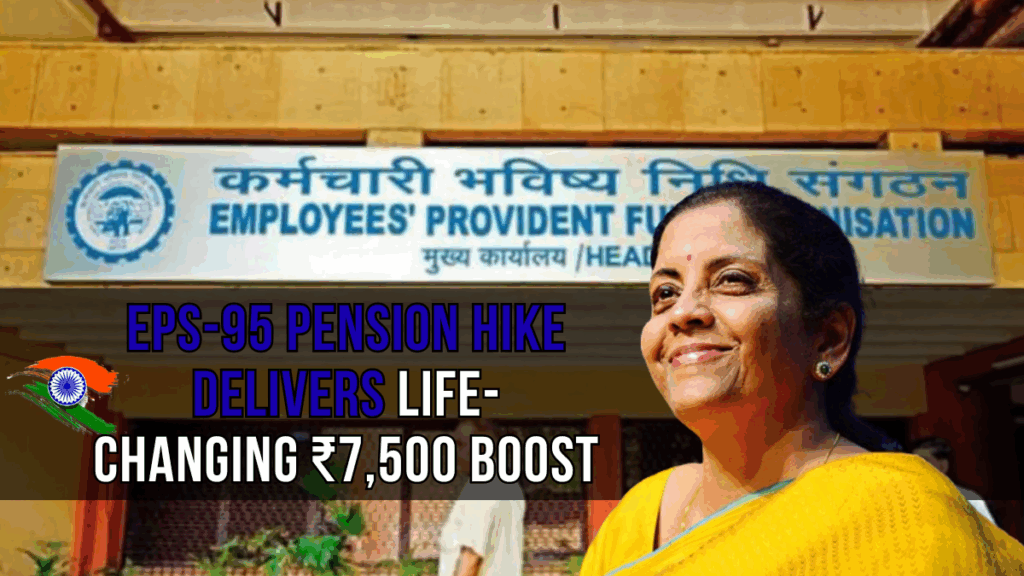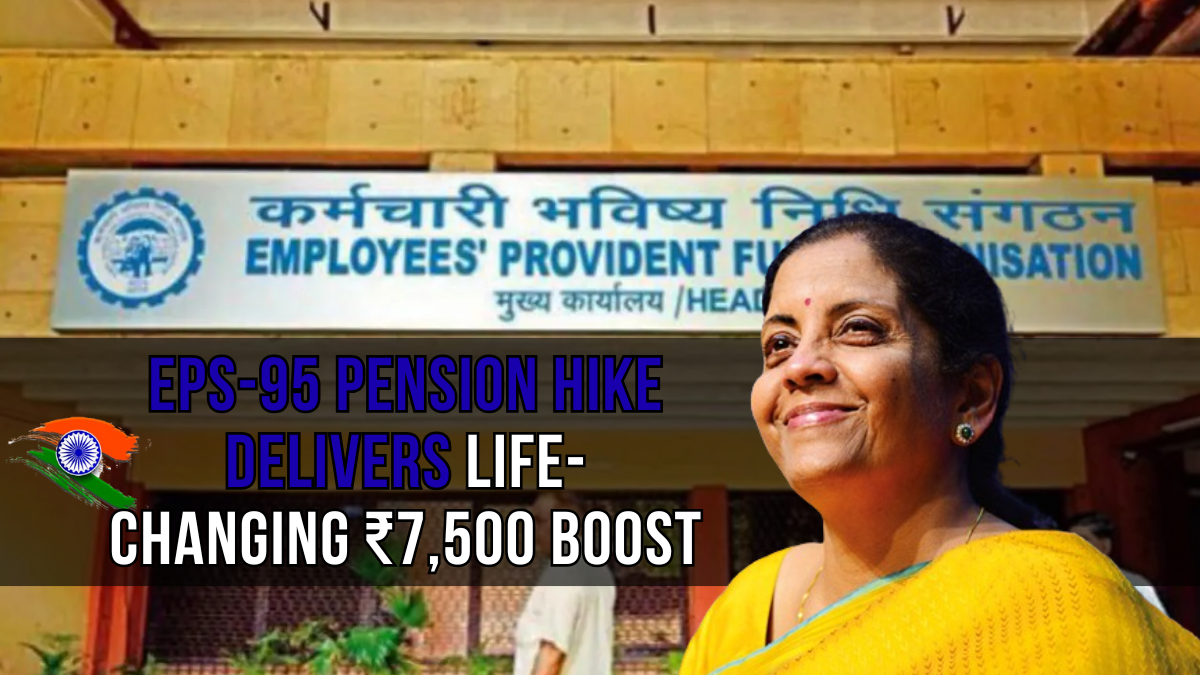For millions of India’s retired private sector workers, August 2025 marked a historic turning point. The Supreme Court’s landmark decision to increase EPS-95 pension benefits from ₹1,000 to ₹7,500 monthly represents far more than a numerical adjustment, it’s a recognition of dignity and decades of contribution by India’s workforce.
This seven-fold increase affects nearly 78 lakh pensioners across the country, many of whom have struggled for years to afford basic necessities on inadequate retirement income. The ruling includes automatic Dearness Allowance adjustments tied to inflation, ensuring pensions maintain purchasing power for the first time since the scheme’s inception in 1995.

The transformation extends beyond individual finances. Healthcare access, nutritional security, housing stability, and social participation—all previously compromised by insufficient pension amounts can now be restored for India’s elderly population.
The Journey to Justice: Understanding EPS-95
The Employees’ Pension Scheme launched in 1995 under the Employees’ Provident Fund Organisation (EPFO) with ambitious goals of providing retirement security for private sector employees. Organizations with 20 or more workers were required to participate, with employees needing minimum 10 years of service for pension eligibility.
However, the scheme’s original structure quickly revealed fundamental flaws. The ₹1,000 monthly minimum pension, reasonable in 1995, became grossly inadequate as inflation eroded purchasing power over three decades. By 2025, this amount couldn’t cover basic groceries, forcing many retirees into poverty or complete dependence on family members.
The pension calculation formula, based on 8.33% employer contributions of basic wages, failed to generate livable retirement income despite regular contributions throughout workers’ careers. This systemic inadequacy sparked widespread dissatisfaction and organized protests by pensioner advocacy groups.
Organizations like the EPS-95 Sangharsh Samiti fought tirelessly through courts and public forums, arguing that existing pension amounts violated the constitutional right to dignified living. Their persistence ultimately led to the Supreme Court’s transformative April 2025 verdict.
Supreme Court’s Historic Ruling
The Supreme Court’s comprehensive decision addressed multiple dimensions of pension inadequacy that had plagued the system for decades. The ruling established clear mandates for immediate implementation and future protection of pensioner rights.
Key Transformation Elements
The minimum pension increase from ₹1,000 to ₹7,500 represents the most visible change, but the ruling encompasses broader reforms. Dearness Allowance inclusion ensures automatic inflation adjustments, preventing the purchasing power erosion that had devastated earlier pensioners.
Implementation occurs automatically without requiring new applications from beneficiaries. The Court mandated immediate execution, preventing bureaucratic delays that might have undermined the decision’s impact.
Legal protections now shield pensioners from arbitrary benefit reductions or implementation postponements. This creates unprecedented security for retirement planning and financial stability.
The decision’s scope covers all eligible EPS-95 pensioners, eliminating discriminatory practices that might have excluded certain groups or regions from benefits.
Legal Precedent and Future Impact
This ruling establishes crucial precedent for pension adequacy standards across India’s social security landscape. Future retirement benefit reforms will likely reference this decision when evaluating minimum benefit levels and inflation protection mechanisms.
The constitutional recognition of dignified retirement income creates legal foundation for challenging inadequate pension schemes in other sectors. Government employees, state pension beneficiaries, and other retirement systems may benefit from similar advocacy efforts.
Dearness Allowance: The Game-Changing Addition
The inclusion of Dearness Allowance transforms EPS-95 from a static benefit system into a dynamic, inflation-responsive program. DA functions as a cost-of-living adjustment, typically revised in January and July based on the All India Consumer Price Index.
Real Monthly Benefit Calculations
Current DA rates significantly enhance the base ₹7,500 pension amount. At 42% DA, monthly payments reach ₹10,650. Higher DA rates of 48% generate ₹11,100 monthly, while 55% DA produces ₹11,625 in total benefits.
These adjustments ensure pensioners maintain purchasing power as essential costs rise. Food prices, healthcare expenses, housing costs, and transportation fees no longer erode retirement security through inflation.
The DA mechanism aligns EPS-95 benefits with government employee pension structures, creating consistency across India’s retirement systems and eliminating discriminatory treatment of private sector retirees.
Long-term Financial Security
Automatic inflation adjustments provide genuine long-term financial protection that was absent from the original EPS-95 structure. Pensioners can confidently plan for healthcare needs, housing expenses, and family obligations without fearing benefit erosion.
This predictable income growth supports better retirement planning and reduces anxiety about future financial security. Families can make informed decisions about eldercare, housing arrangements, and medical preparations.

Eligibility and Implementation Details
Understanding eligibility requirements ensures qualified pensioners receive their enhanced benefits without complications. The Supreme Court’s automatic implementation mandate simplifies the process, but verification steps remain important.
Primary Qualification Criteria
Existing EPS-95 pensioners automatically qualify for the increase, regardless of their current pension amount. Those receiving less than ₹7,500 will see immediate upgrades to the new minimum level.
Members who joined before September 1, 2014, remain eligible under previous contribution rules. Minimum 10 years of contributory service in eligible organizations remains a fundamental requirement.
Simultaneous receipt of other central government pensions may affect eligibility. Pensioners should verify their status with EPFO offices if they have multiple government benefit sources.
Current UAN maintenance and updated KYC documentation facilitate smooth benefit processing. Outdated information could delay payment initiation or create administrative complications.
Verification and Payment Process
Bank account details must match EPFO records to ensure direct deposit functionality. Aadhaar linkage verification confirms identity and prevents fraudulent benefit claims.
The EPFO portal allows online verification of personal details, bank information, and benefit status. Regular monitoring helps identify and resolve potential issues before they affect payments.
Local EPFO offices provide assistance for pensioners experiencing verification difficulties or technical problems. Staff can guide beneficiaries through documentation updates and status confirmation processes.
Life-Changing Impact on Pensioner Communities
The ₹7,500 pension increase creates measurable improvements across multiple aspects of elderly life quality. These changes extend far beyond simple income enhancement to restore dignity and independence.
Healthcare Access Revolution
Enhanced pension amounts enable regular medical consultations, prescription medication purchases, and treatment for chronic conditions that many pensioners previously couldn’t afford. Better healthcare access leads to improved health outcomes and reduced family medical burden.
Preventive care becomes accessible, allowing early intervention for age-related conditions. Regular health monitoring, diagnostic tests, and specialist consultations help maintain quality of life and extend healthy aging.
Dental care, eye examinations, and other specialized medical services gain affordability. Comprehensive healthcare access supports overall well-being and reduces emergency medical expenses.
Nutritional Security and Well-being
The increased pension amount supports diverse food choices essential for healthy aging. Fresh vegetables, fruits, dairy products, and protein sources become affordable options rather than luxury purchases.
Proper nutrition enhances immune function, supports medication effectiveness, and maintains energy levels crucial for independent living. Better dietary quality reduces healthcare needs and improves life satisfaction.
Special dietary requirements for diabetes, hypertension, and other age-related conditions become manageable. Pensioners can afford recommended foods and supplements that support medical treatment plans.
Housing Stability and Independence
Higher pension amounts help cover rent, utility bills, property taxes, and basic home maintenance costs. Housing security reduces stress and provides stable foundation for healthy aging.
Home modifications for accessibility and safety become financially feasible. Grab bars, ramps, improved lighting, and other age-friendly modifications enhance independence and reduce fall risks.
Urban and rural pensioners gain flexibility in housing choices. Options for senior-friendly communities, assisted living arrangements, or aging-in-place modifications expand with increased income.
Economic and Social Transformation
The pension increase generates positive effects throughout India’s economy and social structure. Enhanced purchasing power among 78 lakh pensioners stimulates economic activity and reduces poverty among elderly populations.
Economic Stimulation Effects
Increased consumer spending in local markets benefits small businesses and service providers. Healthcare services, pharmacies, grocery stores, and senior-focused businesses experience growth from enhanced pensioner purchasing power.
Regional economies with high retiree concentrations see particular benefits. Tourist destinations, smaller cities with affordable living costs, and rural areas gain economic stability from predictable pensioner spending.
Reduced pressure on state welfare programs frees government resources for other development priorities. Family support systems experience less financial strain, allowing intergenerational wealth building.
Social Dignity Restoration
The pension increase restores social dignity and self-respect for retired workers who contributed decades to India’s economic development. Financial independence reduces dependence on family members and maintains healthy intergenerational relationships.
Social participation becomes possible again as pensioners can afford transportation, contributions to community events, and participation in religious or cultural activities. Social connections are crucial for mental health and life satisfaction among elderly populations.
Community leadership opportunities emerge as financially secure pensioners can contribute time and resources to local organizations, senior groups, and advocacy efforts.
Planning for Enhanced Benefits
While the Supreme Court mandated automatic implementation, pensioners can take proactive steps to ensure smooth benefit receipt and maximize their enhanced income potential.
Essential Verification Steps
Bank detail confirmation through EPFO records prevents payment delays. Updated account information, including IFSC codes and account numbers, ensures direct deposit functionality.
Aadhaar linkage verification confirms identity authentication for secure benefit delivery. Biometric updates and address verification maintain account security and prevent fraud.
Regular portal monitoring through the official EPFO website provides updates on benefit status, payment schedules, and policy changes. Staying informed helps pensioners understand their rights and available services.
Financial Planning Strategies
Enhanced pension income creates opportunities for better financial planning and security building. Emergency fund establishment, healthcare savings, and family support planning become more feasible.
Investment in health insurance or supplementary coverage helps manage medical expenses beyond basic healthcare needs. Long-term care planning and end-of-life preparations gain importance with increased financial capacity.
Budget creation for enhanced income helps maximize benefit impact. Prioritizing essential needs while allowing for quality-of-life improvements optimizes the pension increase’s value.
FAQs About EPF-95 2025
1. What is the EPS-95 scheme?
A. The Employees’ Pension Scheme (EPS-95) is a government-backed pension program designed for employees working in the organized sector, providing financial security after retirement.
2. What is the new pension amount under EPS-95?
A. With the recent reforms, the minimum monthly pension amount has been increased from ₹1,000 to ₹7,500, offering significant financial relief to retirees.
3. Who benefits from the EPS-95 pension hike?
A. The pension hike benefits approximately 78 lakh retirees in India, ensuring better financial stability and protection against inflation.
4. How does the EPS-95 ensure inflation protection?
A The scheme now incorporates measures to adjust pensions in alignment with inflation, ensuring retirees maintain their purchasing power over time.
5. How can one check their eligibility or claim pension under EPS-95?
A. Eligible retirees can visit the Employees’ Provident Fund Organization (EPFO) website or contact the local EPFO office for further details related to their pension benefits and claims process.
Looking Forward: A New Era for Indian Retirees
The EPS-95 pension hike represents more than financial adjustment, it acknowledges the dignity and contributions of India’s retired workforce. This transformation offers hope, security, and respect to those who built the nation’s private sector economy.
The success of pensioner advocacy organizations demonstrates the power of persistent legal challenges and organized advocacy. Their achievement creates inspiration for future social security reforms and elderly rights protection.
As implementation continues and benefits flow to millions of retirees, this historic decision will likely influence pension policy across India’s social security framework. Future generations of workers can expect stronger retirement protection and dignified aging support.
The integration of inflation adjustments ensures long-term benefit adequacy, preventing the purchasing power erosion that plagued earlier pensioners. This creates sustainable foundation for retirement security that adapts to economic changes.
For India’s current and future retirees, the EPS-95 transformation offers genuine hope for dignified aging and financial security during their golden years.
For More Information Click HERE
